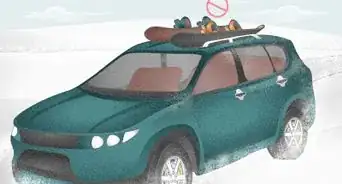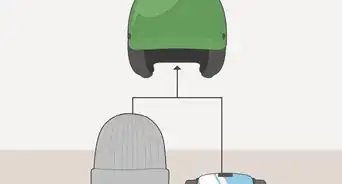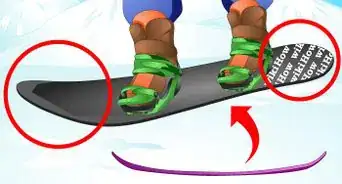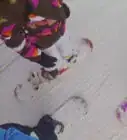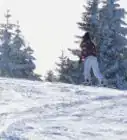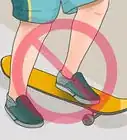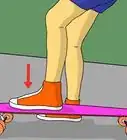X
wikiHow is a “wiki,” similar to Wikipedia, which means that many of our articles are co-written by multiple authors. To create this article, 17 people, some anonymous, worked to edit and improve it over time.
This article has been viewed 130,404 times.
Learn more...
Getting on the lift with a snowboard is not that hard, but when things go wrong, the whole world will seem to despise you for shutting down the lift. Fortunately, many modern lifts have "detachable" chairs that slow down for load and unload making them a great deal easier to learn how to get on and off.
Steps
-
1Release your rear foot from its binding. Unfasten or step out of your rear binding before you get on the chairlift. It must be your rear! Again, make sure your front binding is fastened tightly as well as making sure the leash is attached. Also, be sure to fold down the back part of the rear binding. This is to prevent it being broken by the weight of the chair when you sit down.
-
2"Skate" to the chairlift line. Put the released foot to either side of the snowboard and push. This is called skating. It's like being on a skateboard. You push your rear foot to move and balance on your lead foot.Advertisement
-
3Get in the line and wait until the people in front of you move out to get on their chair. Then move up to the gate and stop. There will be a red line indicating to you where to stop.
-
4When the lift operator gives you the go ahead, move forward to the spot where the chair will pick you up. Make sure the nose of your board is pointed "uphill". Then place your "free foot (back foot)" on the snow on the heel side of the board and stand in the most natural position you can.
-
5Look behind you as the chair approaches, making sure to look to your outside shoulder opposite the center of the chair. Bend your knees slightly, so that when the chair comes around it won’t knock you over. When it is right behind you, sit down on it and have the nose of your board still pointed "uphill".
-
6Sit down in the chair while grabbing the outside of it as it swings in underneath you and touches the back of your legs.
-
7Scoot back in the chair as it sinks a little just before taking off up the hill.
-
8Lift the nose of your board slightly to avoid the edge from catching the snow and dragging.
-
9Once everyone is seated comfortably, lower the safety bar. Make sure you don't hit anyone in the head when you do this. If the safety bar has footrests, you can rest your board on them.
-
10Prepare to get off. Lift up the safety bar. Point the nose of the board up so it doesn't accidentally get planted on the ground.
-
11Get off gracefully. At the exit point put your back foot on the stomp pad on your board which is right in front of your rear binding. Stand up and go straight. After you slow down skate out of the way of the lift and strap your rear foot back onto the board.
- Don't attempt to turn while you are coming off the chairlift as it will risk the odds you fall down. Just go straight till you slow down naturally.
Advertisement
Community Q&A
-
QuestionWhy do I have to release my rear foot from its binding?
 Community AnswerIf you try to to get off the lift with both feet in bindings, you will fall down. I think it's easier to push with my rear foot than pull with my front foot.
Community AnswerIf you try to to get off the lift with both feet in bindings, you will fall down. I think it's easier to push with my rear foot than pull with my front foot. -
QuestionWhen you get off the lift, do you put your rear foot back into the binding?
 lucasCommunity AnswerNo, you don't. Instead, you use a stomp pad, which is a pad with spikes. If you put your foot in the binding, you will trip.
lucasCommunity AnswerNo, you don't. Instead, you use a stomp pad, which is a pad with spikes. If you put your foot in the binding, you will trip. -
QuestionHow do I not fall?
 RuahCommunity AnswerUse the safety bar above you so that you do not fall during the ride up. If you are having trouble falling while getting on, ask the operator to slow the lift down for you.
RuahCommunity AnswerUse the safety bar above you so that you do not fall during the ride up. If you are having trouble falling while getting on, ask the operator to slow the lift down for you.
Advertisement
Warnings
- Beware of older chairs that do not have "detachable" chairs. These chairs generally move more quickly at the loading area and can sink up to a foot or more and can catch your leg under the chair. Keep your free leg out in front of you and off the ground as the chair sinks to avoid catching your leg.⧼thumbs_response⧽
Advertisement
About This Article
Advertisement
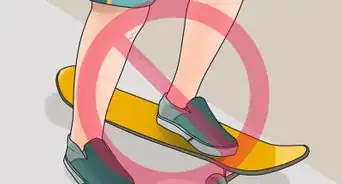
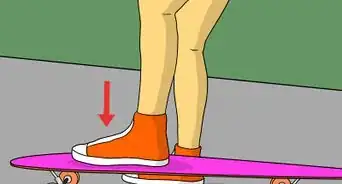
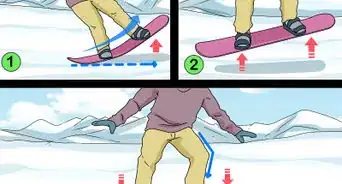
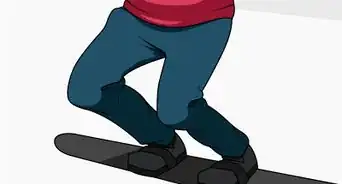
-Step-9.webp)
